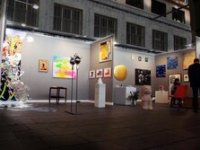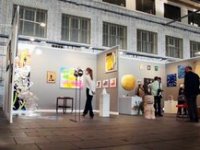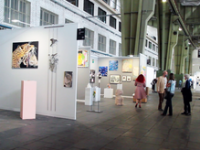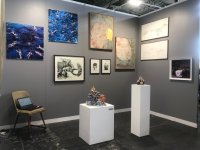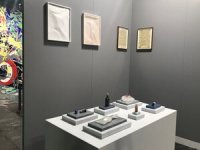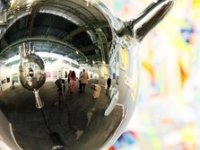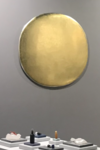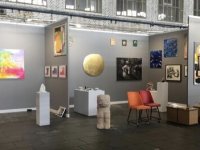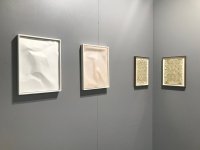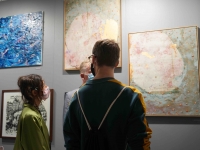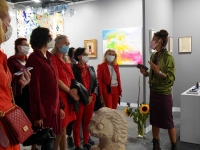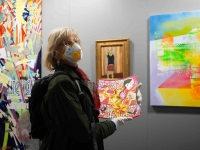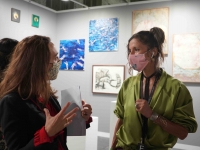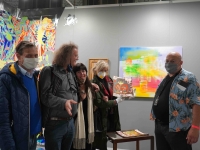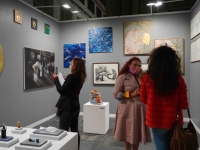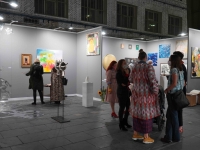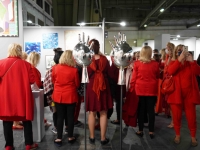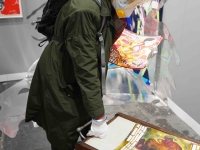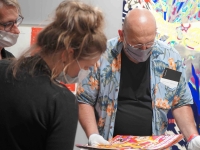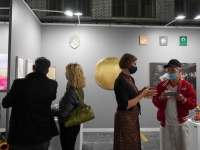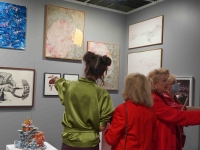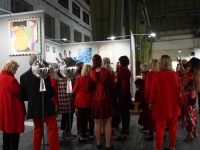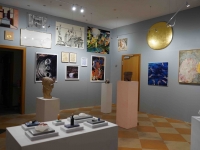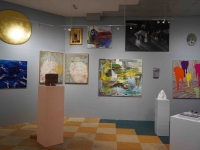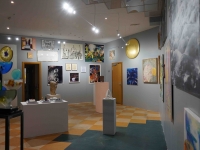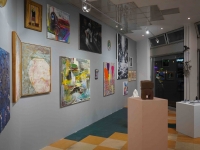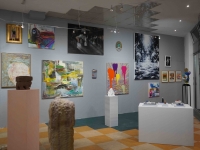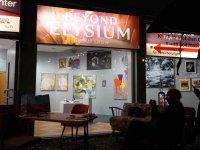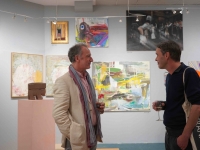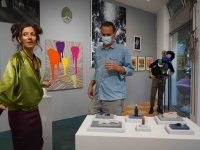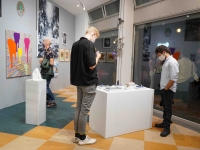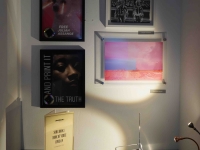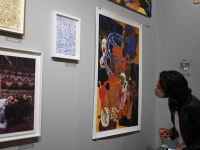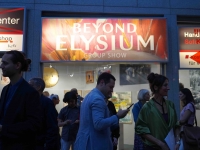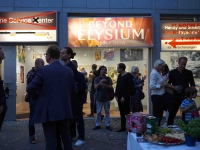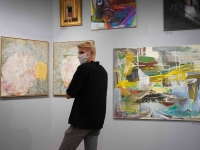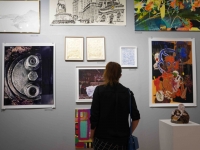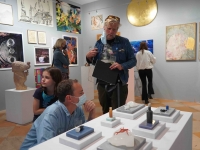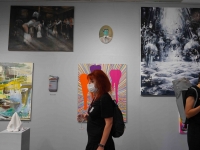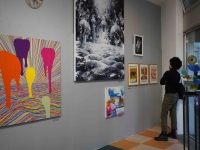In Partnership With

ELYSIUM
Group Exhibition at
@ Tempelhof Airport, Hanger 3-4 / Booth C5
Columbiadamm 10, 10965 Berlin
PROFESSIONAL PREVIEW:
10 September at 2:00-10:00pm
PUBLIC DAYS:
11-12 September: 12:00 – 8:00pm
13 September: 11:00 – 6:00pm
BEYOND ELYSIUM
Group Exhibition at
Kleiner von Wiese Gallery
Friedrichstrasse 204, 10117 Berlin
OPENING:
Wednesday 23 September at 6 – 11pm
EXHIBITION:
24 September – 14 October 2020
Opening Hours: 3-6pm
CHRISTIAN ACHENBACH // NASSER ALMULHIM // CHRISSY ANGLIKER // INNA ARTEMOVA // TOM BIBER // ANDREAS BLANK // ANINA BRISOLLA // CLAUS BRUNSMANN // CLAUDIA CHASELING // ALI DOWLATSHAHI // KERSTIN DZEWIOR // ALI FITZGERALD // DANIEL GRÜTTNER // CHRIS HAMMERLEIN // ANNE JUNGJOHANN // DAVID KRIPPENDORFF // VIA LEWANDOWSKY // MILOVAN DESTIL MARKOVIC // SARA MASÜGER // ALMAGUL MENLIBAYEVA // KIRSTEN PALZ // MANFRED PECKL // DAVID REGEHR // STEFAN RINCK // HUDA AL SAIE // JÖRG SCHALLER // MAIK SCHIERLOH // NINA E. SCHÖNEFELD // KERSTIN SERZ // YASMIN SHARABI // VARVARA SHAVROVA // POLA SIEVERDING // DAVID SZAUDER // VADIM ZAKHAROV // JINDRICH ZEITHAMML // IREEN ZIELONKA
Curated By
Constanze Kleiner, Stephan von Wiese, Rachel Rits-Volloch, Frances Stafford
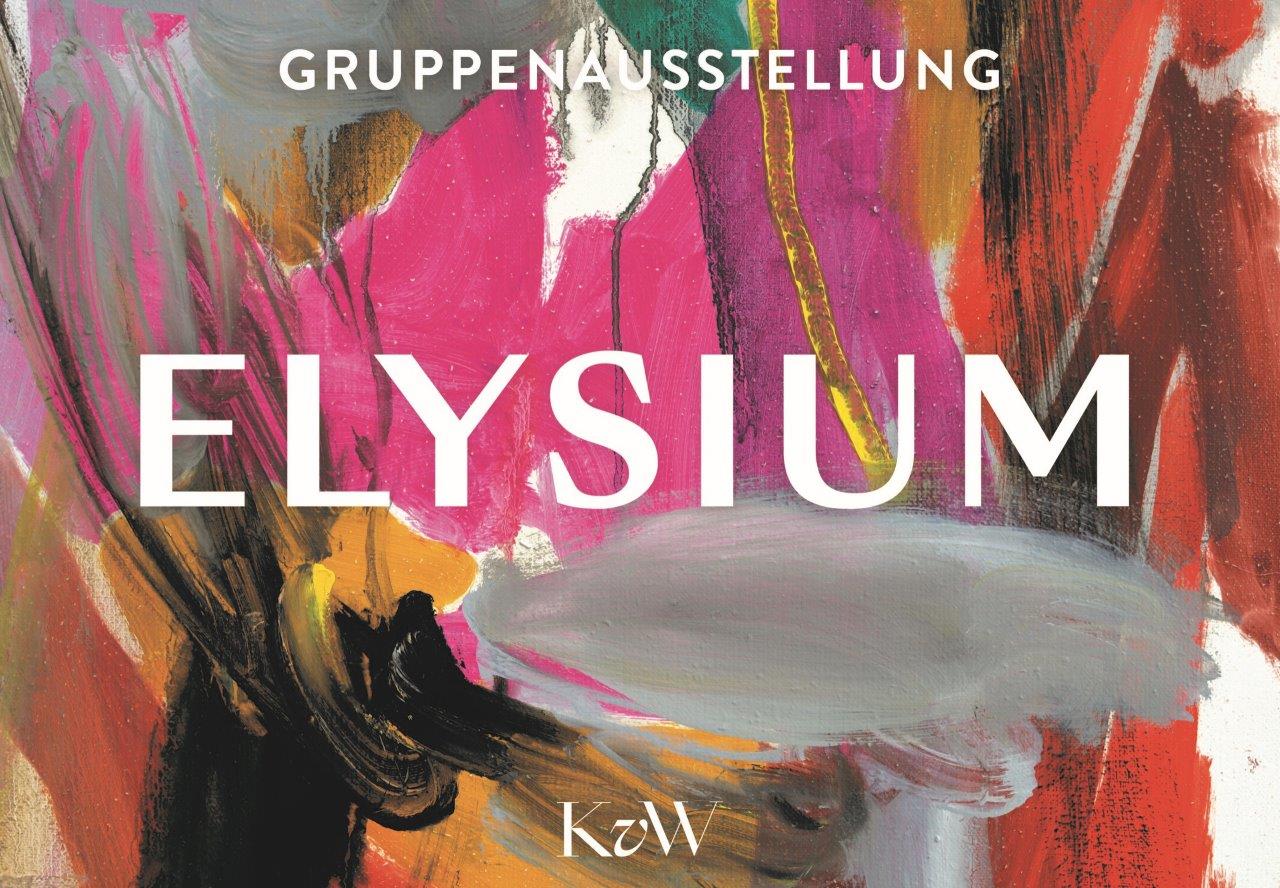
ELYSIUM
There has never before been a pandemic that, like the rampant Covid 19 infection, can apparently endanger all people on earth at the same time; never before have all people on earth, at the same time, asked themselves the question: What is really important now? Through their shared vulnerabilities, never before have so many people faced the realisation of their similarities. And with so much going wrong in the world, our thoughts can’t help but turn to dreams of a happier beyond. “Elysium”, the island of the blessed as a mythological place, as an ideal or state, is an image that contrasts to the sufferings of this world. As a concept, it is present in many cultures and religions as a utopia, as an idea and as hope. The longing for Elysium is therefore a deeply human need. It has been redesigned and defended again and again, and also in connection with religious supremacy and ideologies instrumentalized in power politics, or simply with the need for anesthesia and intoxication or the right to individual love and sexuality.
In our small exhibition, the Elysian realms are not to be understood as a place of flight from the world. Elysium is not to be found only in the unattainable. You find it – beautiful and mysterious, non-violent and full of humor – even in the middle of everyday life, in the here and now. Elysium is also signified in the heightened moments of life, an intoxication with existence, the moment of happiness. This short exhibition aims to raise awareness of this possibility of fulfilled moments.
We all have only this one world and only this one life – and we have only one duty, namely to find happiness for ourselves and for others. To find our “gap”. This corresponds to the meaning of the Middle High German word for “luck”, which was also “gap”. Nobody can really be happy if they have no chance, no gap in which to realize themselves, and nobody can be “happy” or “successful” in the face of the misery of others. Since Corona, more people around the world have become aware of this than ever before.
It is all the more exciting to be able to tie the the ELYSIUM exhibition in with the themes of the previous large group exhibition by KLEINERVONWIESE and MOMENTUM, “bonum et malum”. What does “bonum et malum” / good and evil mean in our current times? What exactly is paradise today?
The aim of the ELYSIUM exhibition is to interrogate this from a wider perspective and, at the same time, refer to the phenomenon of the connectedness of all people, despite our supposedly profound cultural differences. We all have common roots, as expressed in our cultural histories, which are often older than the history of the respective religions of the various peoples. All Abrahamic religions have a common, geographically localized starting point, namely the city of Uruk, which was a cultural hotspot in Mesopotamia and the hometown of Abraham more than 5000 years ago. However, Gilgamesh, the hero of an even older mythical tale, was also born here. The Sumerian-Babylonian Epic of Gilgamesh (12th century BC) tells of the search for an earthly paradise.
According to current knowledge, this “Dilmun” (the Sumerian name for a paradisiacal land) is the cultivated land of the gardens in what was then Bahrain and nearby areas. Contemporary research assumes that these Oriental Gardens of Paradise were the inspiration for the Occidental Paradise Garden. Seen in this way, the inspiration for the Garden of Eden of the Jews, Christians and Muslims came from Bahrain and from the Dilmun culture around the Persian Gulf.
In this context, and as a result of initial collaborations with partners from this region, KLEINERVONWIESE & MOMENTUM are also showing two Arab artists, with more to follow. The assembled positions of the ELYSIUM exhibition consciously or unconsciously reflect these interrelationships and – also thinking about the challenges and puzzles of Corona – at the same time the questions: Why do we no longer know about these correlations? Why have we lost our consciousness of what connects us as humans, regardless of where we live and what we believe in? The curators trust in the interplay, correspondence and dissonance of the works, which alternately communicate with, and may reinforce and complement, one another.
Much is currently being rethought in how we live our daily lives and go about our professional lives. Above all, however, when museums and galleries had to close, the Corona crisis showed that work in the artists studios did not come to a standstill. It is especially in times of crisis that we need the clairvoyance of art and its real, sensual knowledge. The ELYSIUM exhibition, and its sister show – BEYOND ELYSIUM – are designed to support art-lovers, artists and their galleries at a time of crisis, and to remind us all that perhaps Elysium can be found in the small miracle of simply bringing people together.
[Constanze Kleiner]
MOMENTUM Collection Artists Featured in ELYSIUM:
Inna Artemova
Inna Artemova, born in Moscow, studied architecture at the Moscow Architectural Institute (MArchI). For her diploma project, she received the 2nd prize of the Russian Federation. In 1998 she moved to Berlin and started to focus on her work as an artist in the field of painting and drawing. Recently, Inna Artemova has participated in: the Lahore Biennale, Pakistan (2020), and in 2019, the Kyrgyz National Museum of Fine Arts presented her works in the solo show “Landscapes of Tomorrow”. She has had numerous solo and group exhibitions in Germany, Austria and Italy. Additionally, her works were shown at international art fairs in Germany, the Netherlands, Switzerland, Denmark, the US, and Japan.
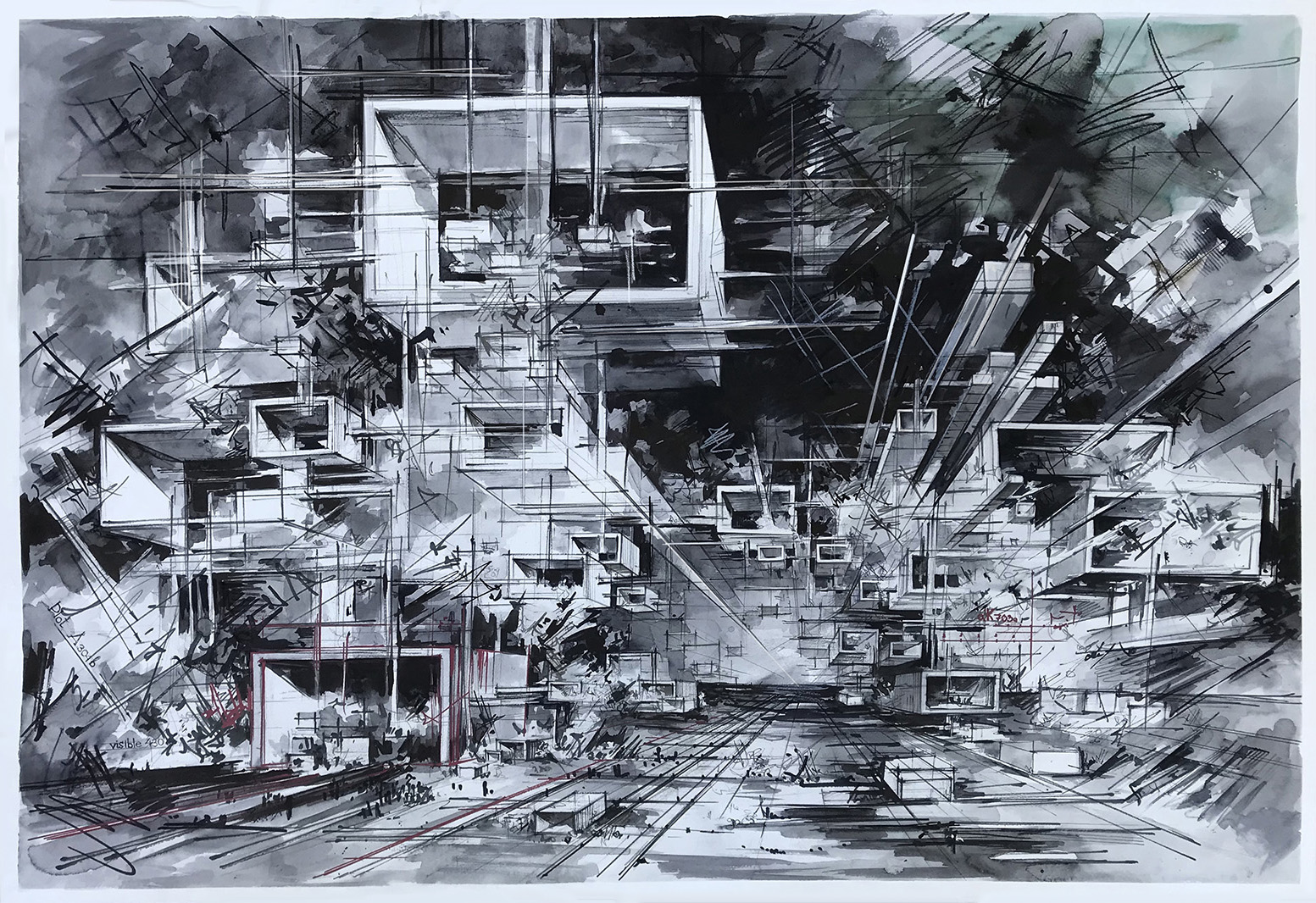
Inna Artemova, Utopia #4532 (2020)
ink, marker, pencil on paper, 75 x 110cm

Inna Artemova, Utopia #5569 (2020)
ink, marker, pencil on paper, 75 x 110cm
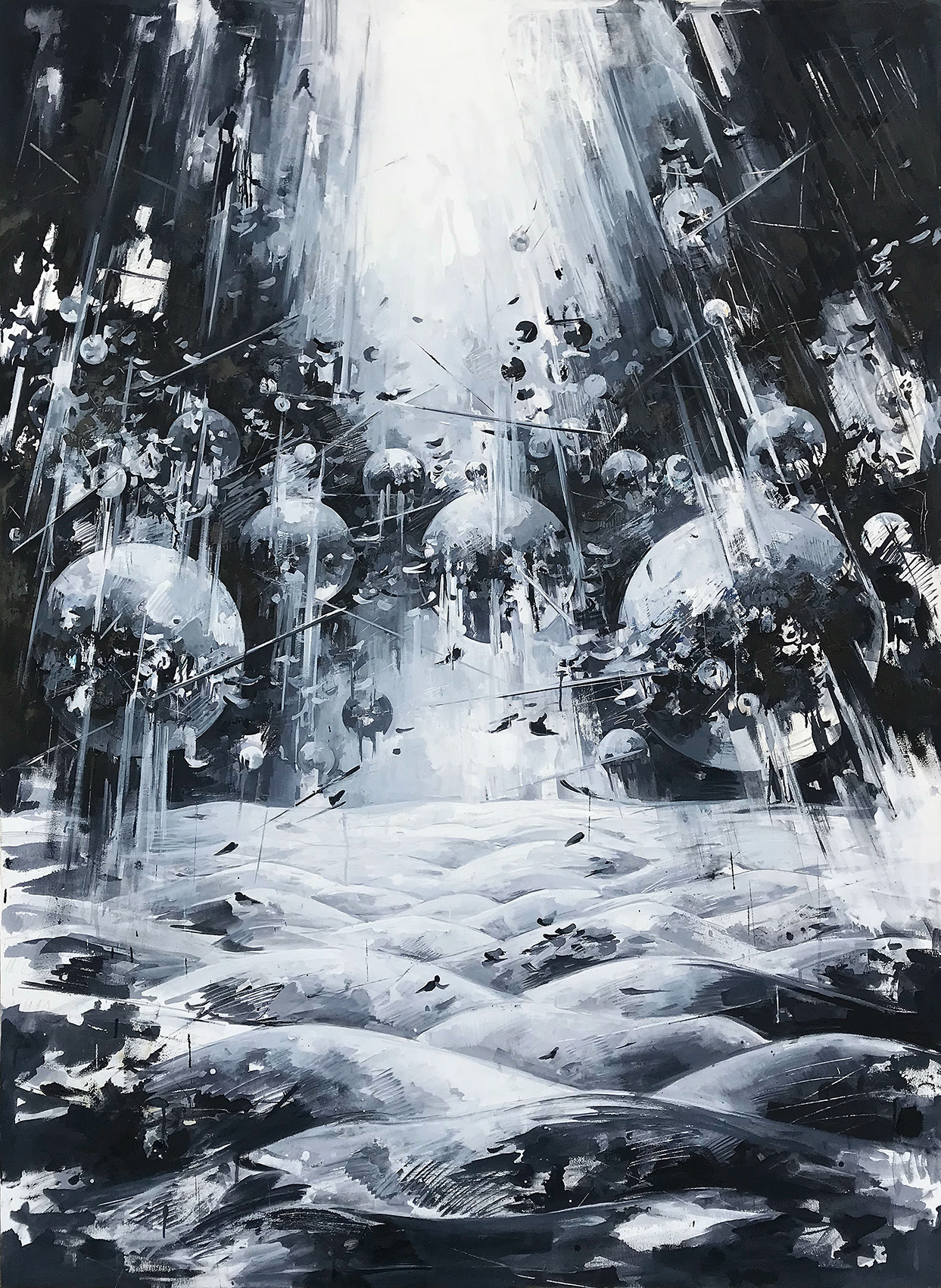
Inna Artemova, Utopia IX (2017)
oil in canvas, 190 x 140cm
Artemova’s practice remains heavily influenced by her professors at the MArchI in Moscow, the “Paper Architects“, a movement originating in the 1980s that developed futuristic architectural creations never intended to be realized. The visionary projects of the Paper Architects and her experience of the failure of the communist utopia with the fall of the Soviet Union, has led Artemova to explore, through her constructivist painting style, the ideas of architectural utopias from the 1960s up to her own futuristic visions. In creating utopian landscapes and spaces, Artemova interrogates the future of living spaces and their impact upon human relationships. The concept of utopia stands for a space of possibility in human consciousness in which the crucial questions have to be answered again and again: Is there no alternative to the reality in which we live? What will we do in the future? Do we have to fail because of our ideal ideas?
Claudia Chaseling
Claudia Chaseling is a German artist, born in Munich in 1973, currently living and working between Berlin, Germany and Canberra, Australia. She is known for developing the practice of Spatial Painting, comprised of canvases and sculptural paintings with mixed media on objects, walls and floors. The artist has exhibited her works in over fifty solo and group exhibitions, notably in the United States, Australia, Germany, Sweden, Luxembourg, Austria, Switzerland, and beyond. Recent exhibitions in 2017 include solo exhibitions at Magic Beans Gallery in Berlin, and the Wollongong Art Gallery, Australia, as well as a group exhibition at Richard Taittinger Gallery, New York. The “Verlag für zeitgenössische Kunst und Theorie” published her first extensive monograph in 2016. Claudia Chaseling studied at Academy for Visual Arts in Munich, Germany, and Academy of Visual Arts in Vienna, Austria, before graduating in 1999 from the University of the Arts (UdK) in Berlin, Germany. She received her Masters degree in Visual Arts from both the University of the Arts Berlin, in 2000, and the School of Art, Australian National University in Canberra, Australia, in 2003. In 2019 the artist is completing her PhD in Visual Arts at the School of Art, Australian National University in Canberra, Australia. Major grants and scholarships received in Australia and Germany include the DAAD; the Samstag Scholarship; the Studio Award of the Karl Hofer Society; the Australia Council for the Arts Grant in 2014; and the 2015/16 artsACT Project Grant. She has taken part in various international visiting artists programs and artists residencies, including Texas A&M University; Yaddo in New York; the International Studio and Curatorial Program in New York City; the Australian National University (ANU); amongst others.
This work is presented in parallel to Claudia Chaseling solo exhibition mutopia5 at the Australian Embassy Berlin [also presented by MOMENTUM]. Chaseling’s practice of Spatial Painting, at once 2- and 3-dimensional, takes us on a psychedelic journey through the nuclear chain leading to depleted uranium and its toxic aftermath. metal 2 continues Chaseling’s inquiry into the ways that abstract, non-representational painting can communicate narratives with a socio-political meaning – namely, the radioactive contamination of depleted uranium munitions. The imagery of her Spatial Paintings consists of distorted landscapes, estranged places, mutated creatures and plants whose deformation is caused by radioactive poisoning. Her images, often including text and URLs referencing her source materials, are not predictions of some post-apacalyptic future, but rather the result of her research into historic and ongoing ways in which we continue to poison our planet with radioactive materials.

Claudia Chaseling, metal 2 (2015)
pigments, egg tempera and oil on canvas, 100 x 120cm
“The painting metal 2 seems at first glance to have a biomorphic abstract dynamic. On a closer look, one can decode explosive forms, grenades and even the contour of a particular war plane. The depicted scene is sourced from photos of a US plane in action shooting depleted uranium munitions above a middle eastern landscape. In the middle of the painting, one can see another layer embedded into the painting: the shape of a depleted uranium rocket. The title of the work refers to this part of the painting and the heavy metal ‘uranium’ used in munitions in wars today.”
– Claudia Chaseling
David Krippendorff
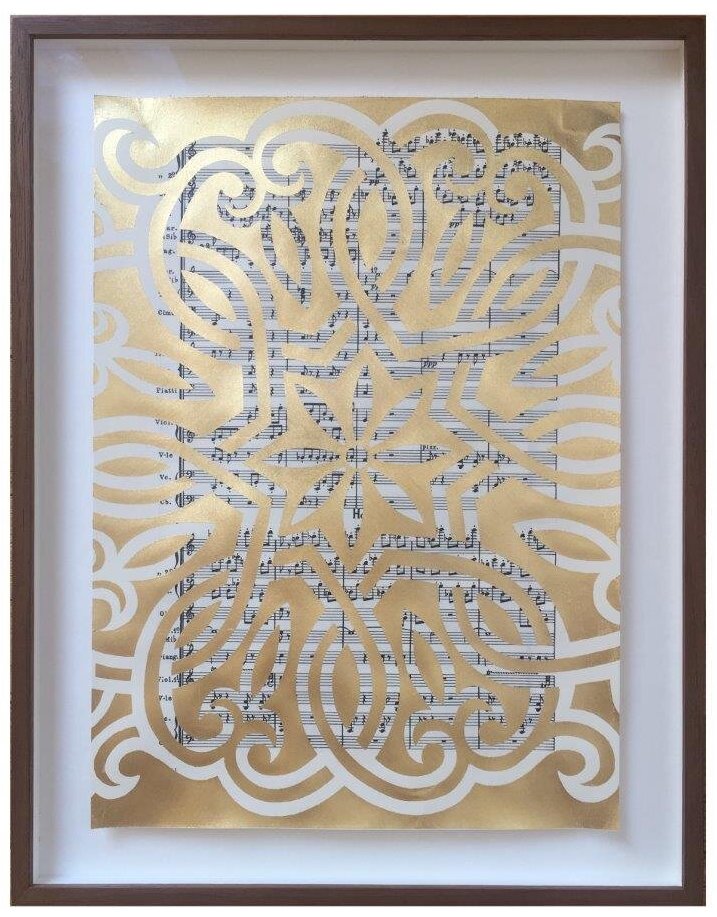
David Krippendorff, Silenced with Gold 1 (2017)
Gold leaf on paper
David Krippendorff, born in Berlin in 1967, is a US/German interdisciplinary artist and experimental filmmaker. Currently based in Berlin, he grew up in Rome, Italy, and studied art at the University of Fine Arts in Berlin, Germany, where he graduated with a masters degree in 1997. His works, films and videos have been shown internationally, including: the New Museum (New York), ICA (London), Hamburger Kunsthalle (Hamburg), Museum on the Seam (Jerusalem). He has participated in four Biennials (Prague, Poznan, Tel Aviv, and Belgrade), as well as in many international art and film festivals worldwide.
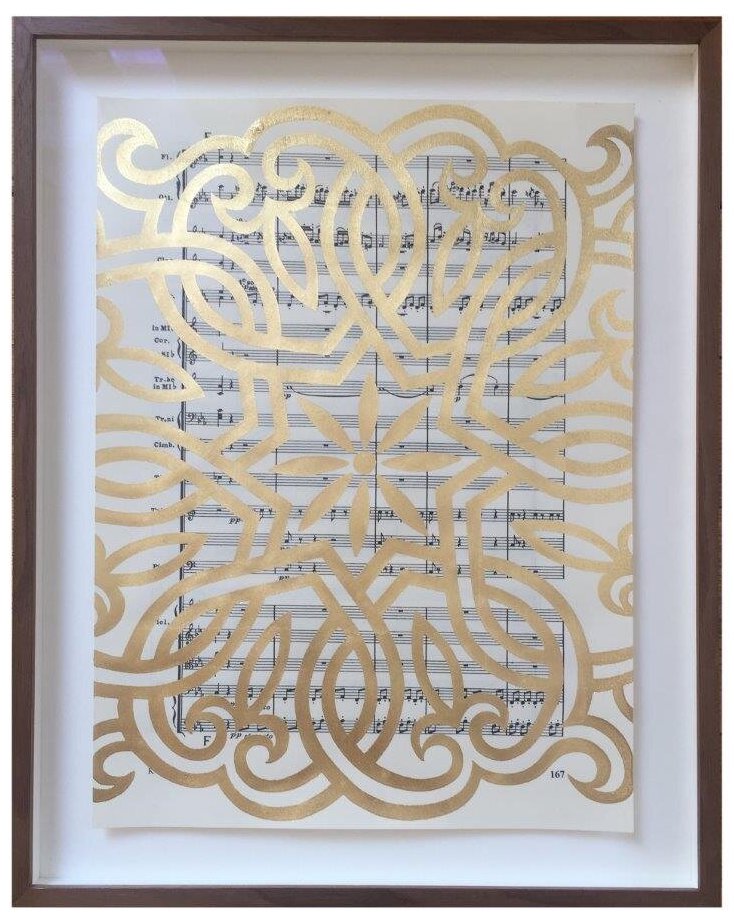
David Krippendorff, Silenced with Gold 2 (2017)
Gold leaf on paper
Emerging from Krippendorff’s video work Nothing Escapes My Eyes (2015), Silenced with Gold 1 & 2 are part of a series of works on paper superimposing arabic designs in gold leaf onto the musical score for Verdi’s opera Aida. Nothing Escapes My Eyes is about a silent transformation of a place and a human being, both subjected to the melancholy of conforming. The film was inspired by the famous opera Aida, to depict in a metaphoric form current issues of cultural identity, loss and the pressures to conform. The film refers to the following historical event related to this opera: Aida premiered in Cairo in 1871 at the „Khedivial Opera House“. One hundred years later the building was completely destroyed by fire and replaced by a multi storied parking garage. Nevertheless, to this day, the place is still named Opera Square: Meidan El Opera. The film combines this urban alteration with the painful transformation of a woman (actress Hiam Abbass) in the process of shedding one identity for another. With no dialogue, the film is backed by a musical excerpt from Verdi’s Aida whose lyrics express the difficulties of being loyal to one’s country and cultural identity. The personal and urban transformation tackles on issues of identity, loss and disorientation as a result of historical colonialism and contemporary globalization.
Milovan Destil Marković
Milovan Destil Marković was born in 1957 in Yugoslavia/Serbia. He has lived and worked in Berlin since 1986. Having studied painting at the Faculty of Fine Arts at the University of Arts, Belgrade, where he graduated in 1983. Marković’s works can be found in numerous public and private collections throughout the world: in between others in the Contemporary Art Museum, Kumamoto/Japan; Neuer Berliner Kunstverein, Berlin/Germany; Museum of the City of Belgrade/Serbia; Istanbul Art Museum Foundation, Istanbul/Turkey; Museum of Contemporary Art, Belgrade/Serbia; Kunstmuseum Düsseldorf, Düsseldorf/Germany and Landesmuseum Joanneum, Graz/Austria, The Artists’ Museum Lodz/Poland. Marković has exhibited extensively in Europe, Asia and in the Americas.
His work was featured at 42nd Venice Biennial Aperto, 4th Istanbul Biennial, 46th Venice Biennial, 6th Triennial New Delhi, 5th Biennial Cetinje, Sao Paulo Biennial, Hamburger Bahnhof – Museum für Gegenwart Berlin, Contemporary Art Museum Kumamoto, P.S.1 Contemporary Art Center New York, Moderna Museet Stockholm, Ludwig Museum for Contemporary Art Budapest, Saarland Museum Saarbrücken, The Artists’ Museum Lodz, National Museum Prague, Museum of Contemporary Art Belgrade, Landesmuseum Graz, Kunstmuseum Duesseldorf, Art Museum Foundation – Military Museum Istanbul, Kunst-Werke Institute for Contemporary Art Berlin, Kunstverein Hamburg, Kunstvoreningen Bergen, Galleri F15 Oslo, Nishido Contemporary Art Tokyo, Fei Contemporary Art Center Shanghai, the 56th October Salon Biennial in Belgrade, Museum of Modern Art Ljubljana, Museum of Contemporary Art Banja Luka, and many others.
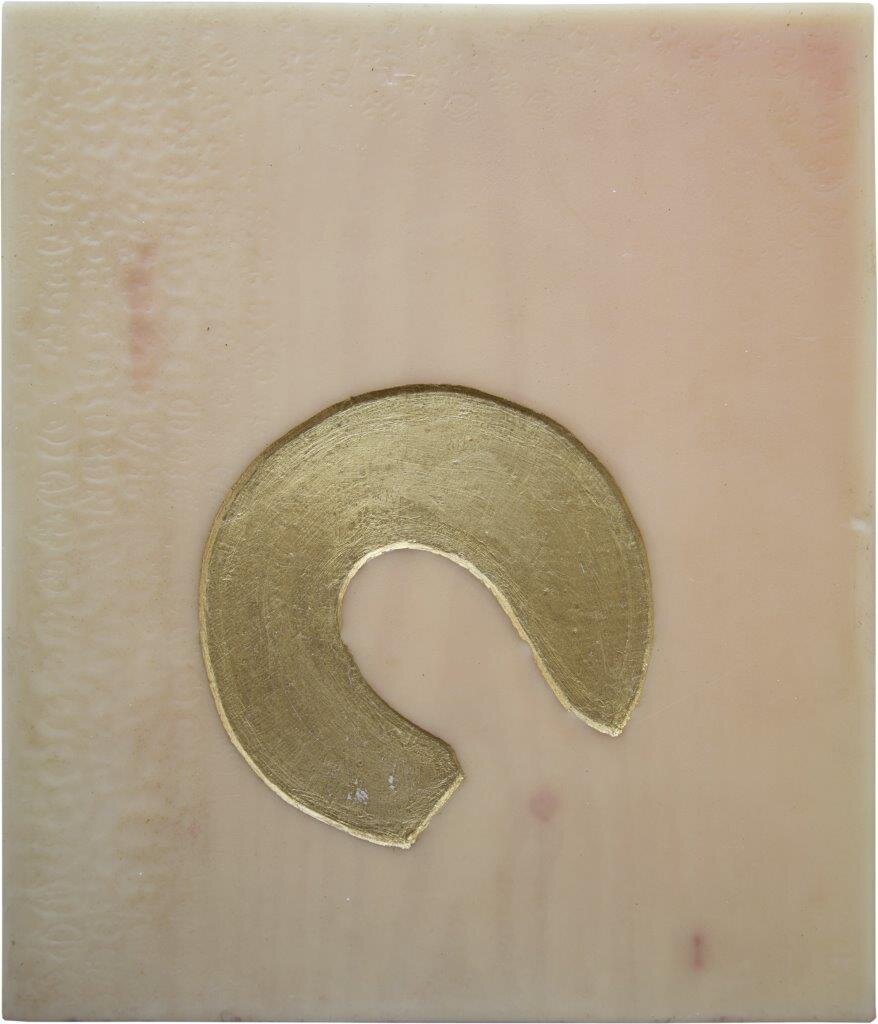
Milovan Destil Marković, Ivory Lipstick Aureole (1992)
gold leaf, lipstick, beewax, paraffin on wood, 26,5 x 22,5 cm
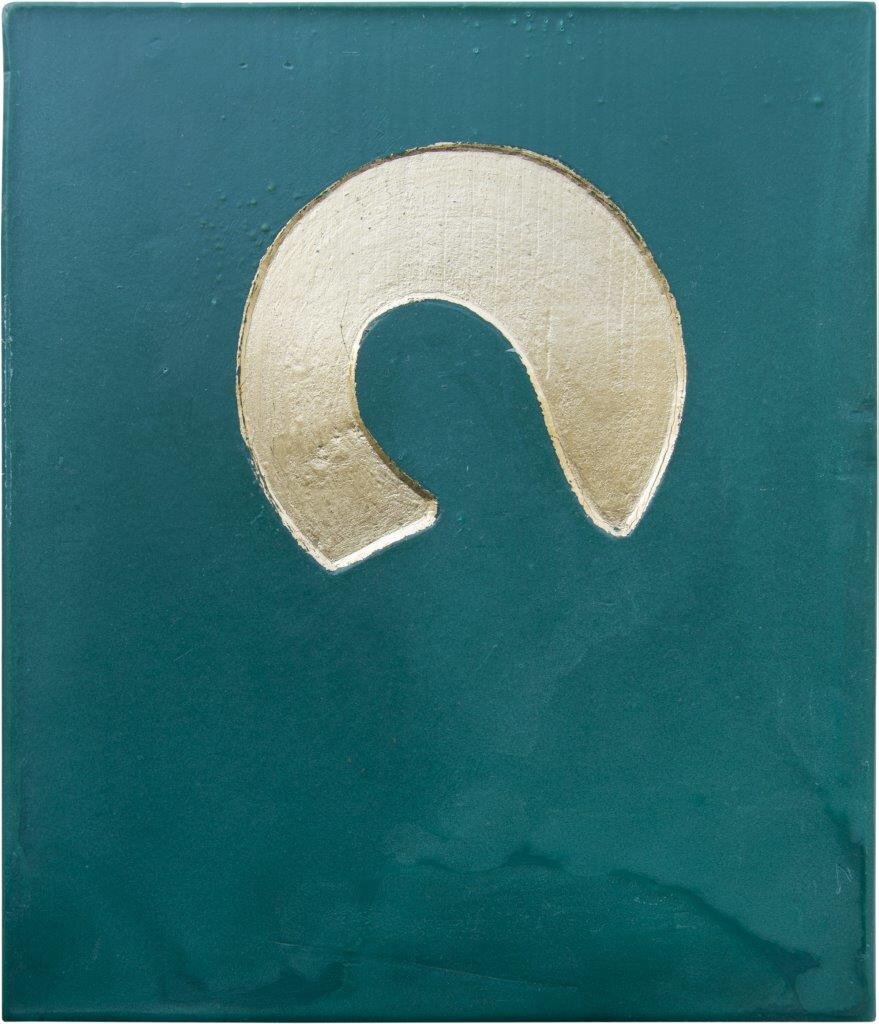
Milovan Destil Marković, Green Lipstick Aureole (2016)
gold leaf, lipstick and paraffin on wood, 26,5 cm x 22,5 cm
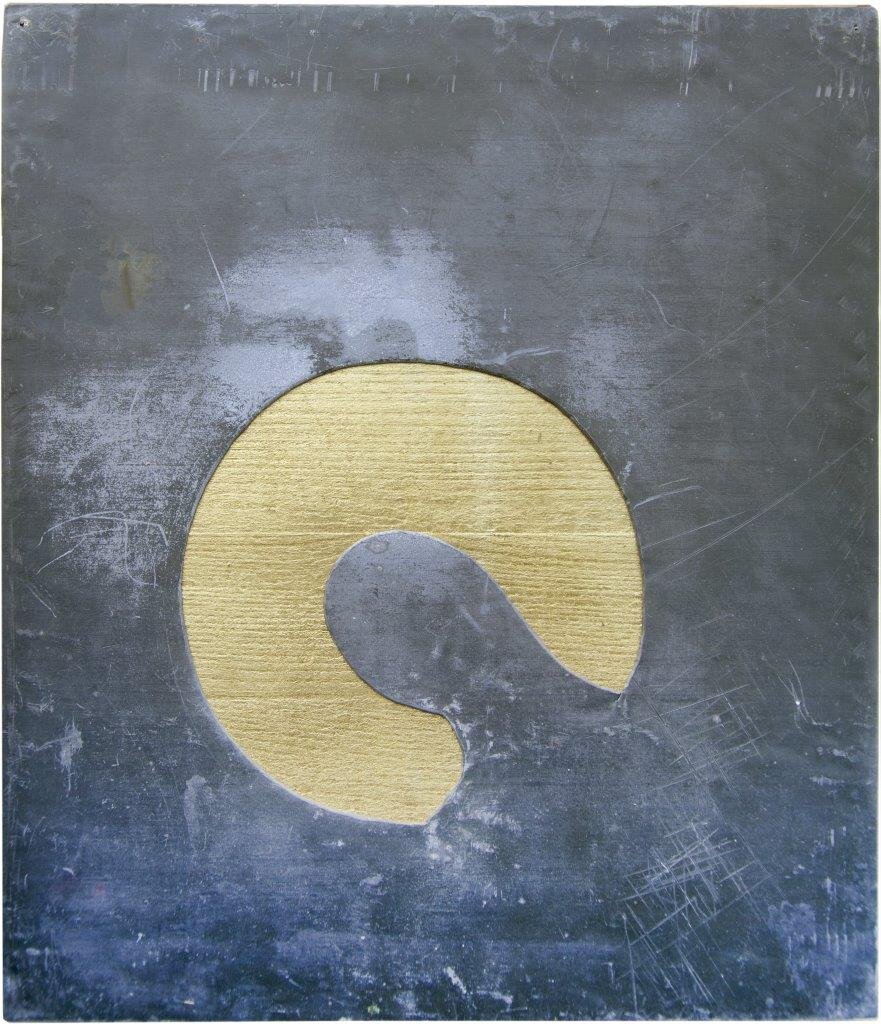
Milovan Destil Marković, Lead Aureole (1992)
gold leaf and lead on wood, 26,5 x 22,5 cm
Almagul Menlibayeva
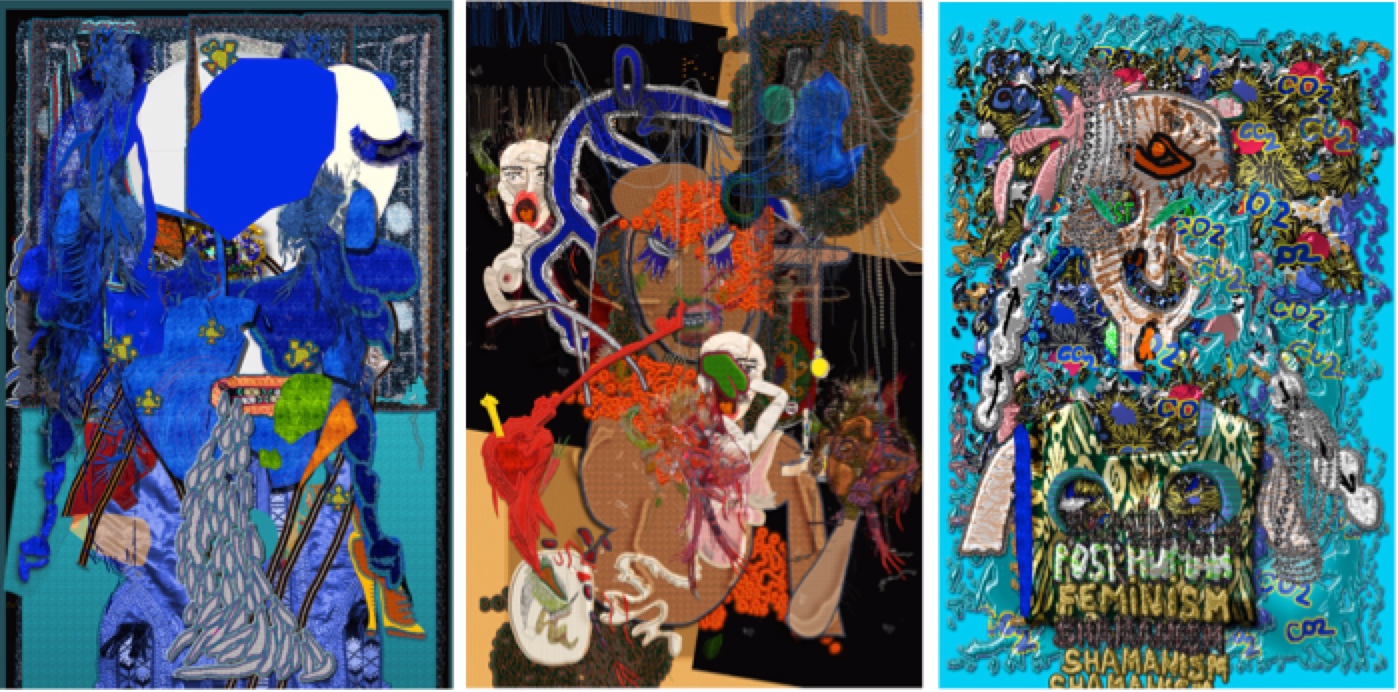
Almagul Menlibayeva, Walking Head (2019), Shamans 02 (2018), Posthuman Shamanism (2019)
inkjet print on archival paper, 110 x 175.76 cm
Video artist and photographer Almagul Menlibayeva holds an MFA from the Art and Theatre University of Almaty. She works primarily in multi-channel video, photography and mixed media installation and her work addresses such critical issues of post-Soviet modernity as social, economic, and political transformations in Central Asia, de-colonial re-imaginings of gender, environmental degradation, and Eurasian nomadic and indigenous cosmologies and mythologies.
In conjunction with her solo exhibition Transformation at the Grand Palais in Paris (France, 2016-2017), she was awarded the prestigious Chevalier Ordre des Arts et des Lettres by the French Minister of Culture in 2017. Other awards include the ‘Daryn’ State Prize of Kazakhstan (1996), and the ‘Tarlan’ National Award of the Club of Maecenas of Kazakhstan (2003). She was also the Winner of the Grand Prix Asia Art at the II Biennial of Central Asia, in Tashkent, Uzbekistan (1995) and the Winner of the Main Prize of the International Film Festival Kino Der Kunst (2013) in Munich, Germany.
Menlibayeva has gained international recognition by participating in: the Venice Biennale, Italy (2005, 2007, 2009, 2015); Sydney Biennale, Australia (2006, 2012); the Sharjah Biennial, UAE (2010); the Mediterranean Biennale, Israel (2010); the Moscow Biennale, Russia (2011, 2015); the Kiev Biennial, Ukraine (2013); the Daegu Photo Biennale (2016); and the Gangwon International Biennale, South Korea (2018).
Selected solo exhibitions include:Videoart at Midnight #98: Almagul Menlibayeva, Berlin (2018); Transformation, Grand Palais, Paris, France (2016-2017); Union of Fire and Water, 56th Venice Biennial, Italy (2015); Transoxiana Dreams, Videozone, Ludwig Forum, Aachen, Germany (2014); An Ode for the Wastelands and Gulags, Kunstraum Innsbruck, Austria (2013); Daughters of Turan, Casal Solleric, Palma De Mallorca, Spain (2012); LATT:Europe at large #6, Museum van Hedendaagse Kunst (M HKA), Antwerp, Belgium (2010); Kissing Totems, Priska C. Juschka Fine Art, New York, USA (2008). Recent selected group exhibitions include: Haifa Museum, Israel (2018); Neues Museum in Nuremberg, Germany (2018, 2016); Astana State Museum, Kazakhstan (2018, 2016); Museum van Hedendaagse Kunst, M HKA, Antwerp, Belgium (2017-2020, 2010); National Museum of Contemporary Art, Athens (EMST), Greece (2017).
Almagul Menlibayeva made her curatorial debut with Bread & Roses: Four Generations of Kazakh Women Artists, co-curated with David Elliott and Rachel Rits-Volloch, organised by MOMENTUM in partnership with the National Museum of the Republic of Kazakhstan (2018).
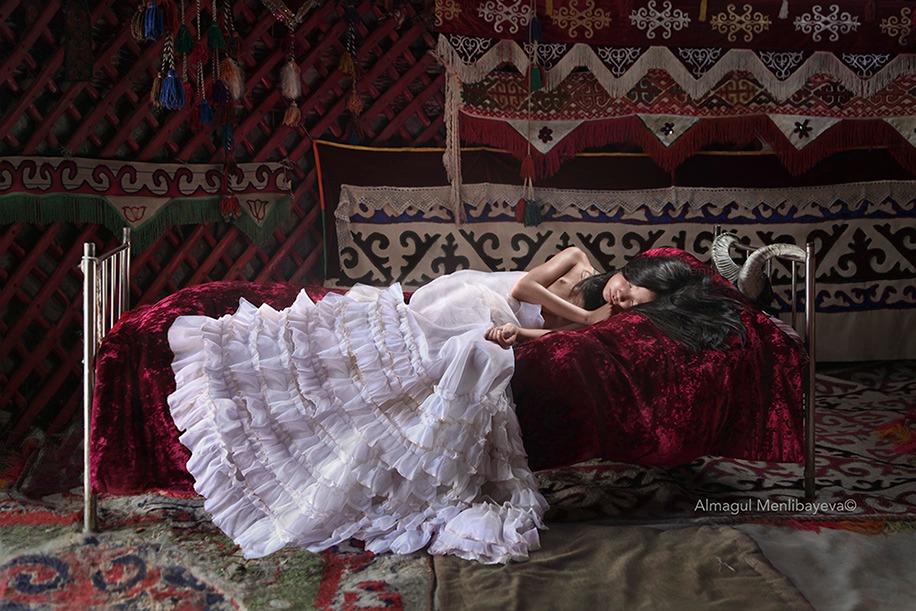
Almagul Menlibayeva, Dilora (2013)
inkjet on soft Hahnemühle paper, 55 x 50 cm
From the series Milk for Lambs (2010)
In the Steppes of her native Kazakhstan, Menlibayeva stages and films complex mythological narratives, with reference to her own nomadic heritage and the Tengriism traditions of the cultures of Central Asia. The series of works in Milk for Lambs explores the emotional and spiritual residues of an ancient belief system as well as a historic conflict, still resonating among the peoples of Central Asia today, between the Zoroastrian ideology of former Persia, spreading widely across Eurasia and influencing Western politicians and philosophers and the mysterious Tengriism (sky religion) reaching as far as the Pacific Ocean. The nurturing earth goddess Umai and favorite wife of Tengri, the god of the sky, much like Gaia in the Greek mythology, created life on earth out of herself. This figure of the ‘Earth Mother’ symbolizes the close relationship of the people to the land and its given riches, through symbolic rituals of animals and humans feeding off of her body and drinking her milk. Often described as “punk-shamanism,” Menlibayeva’s videos are embedded in theatricality that leads them through a complex set of references — from tribal symbolism to images of the communist industrial past. Milk for Lambs begins as the story of the artist’s grandfather, merging documentation of an annual ritual of the formerly nomadic peoples with a stylised fantasy of their myths and legends.
Kirsten Palz
Kirsten Palz, born Copenhagen 1971. is a visual artist working in Berlin. She holds a degree in Computer Science from the IT-University in Copenhagen and a degree of Fine Arts/ Painting from School of Visual Arts in New York City. In 2007, Kirsten Palz initiated her ongoing archive of manuals. The archive is a work in progress consisting today of 317 manuals, including objects, prints on paper and drawings. The manuals engage with various topics, such as dreams, memories, myth, sculpture and social space. Kirsten Palz has shown her works in spaces in Germany and abroad.
Recent works were presented in F******* -Towards New Perspectives on Feminism, Neue Berliner Kunstverein (nbk), Berlin and ff /Temporary Autonomous Zone /2/ in Galerie im Körnerpark, Berlin. Palz’s performances frequently take place non-officially in the Hamburger Bahnhof and the Museum für Kunst und Gewerbe, Hamburg – outside the institution’s listed program – and include readings and experimental guided tours for audiences.
Kirsten Palz’s series of Song Books emerge from her practice of “Sculpture as Writing”, encompassing her manuals and other text-based works. Song Book, Book of Verse, Covid-19 was created especially for the ELYSIUM exhibition, and has been acquired by the MOMENTUM Collection.
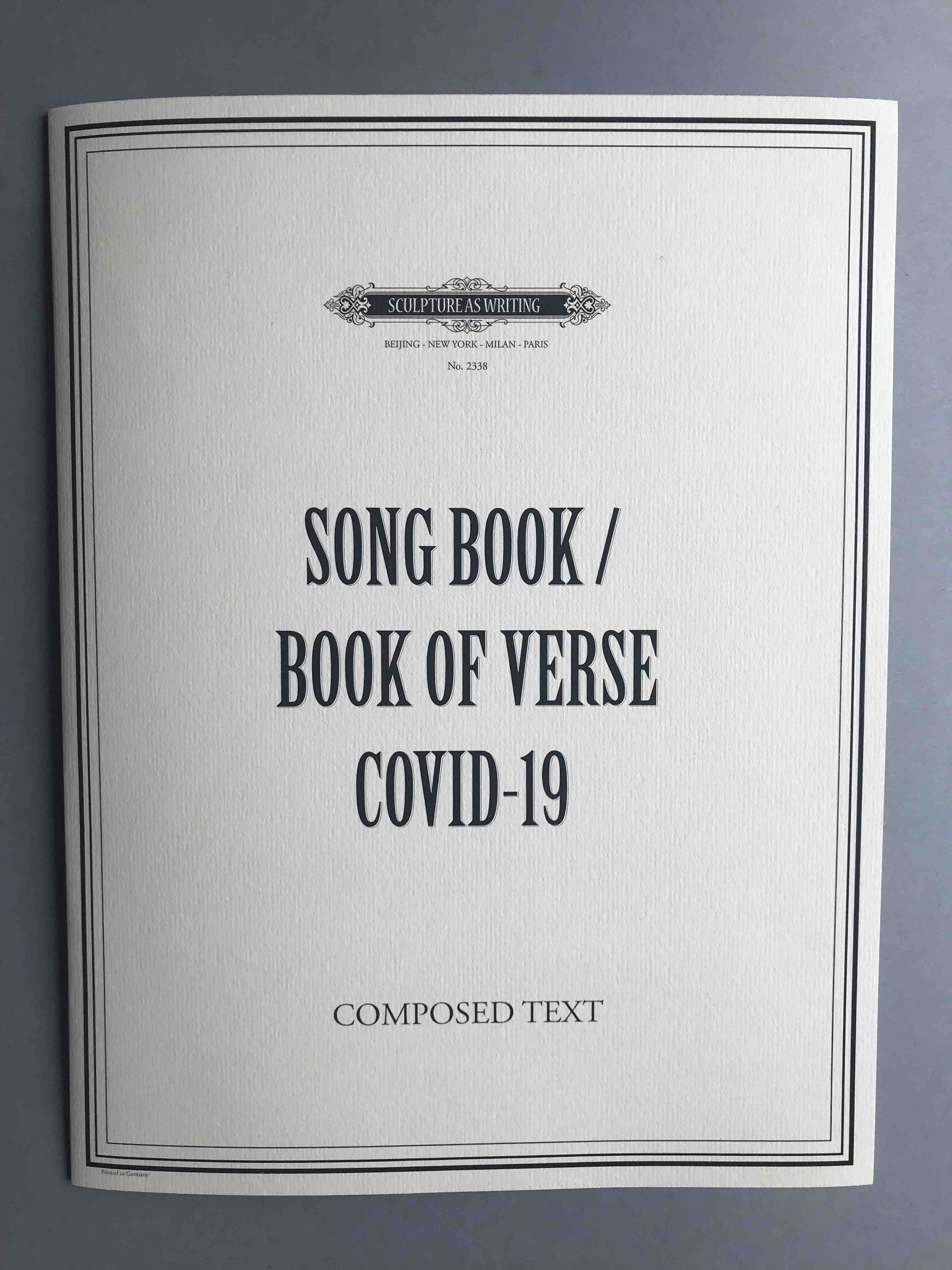
Kirsten Palz, Song Book, Book of Verse, Covid-19 (2020)
Limited edition prints, Number of prints: 100 pieces. Stamped and signed by the artist
Nina E. Schönefeld
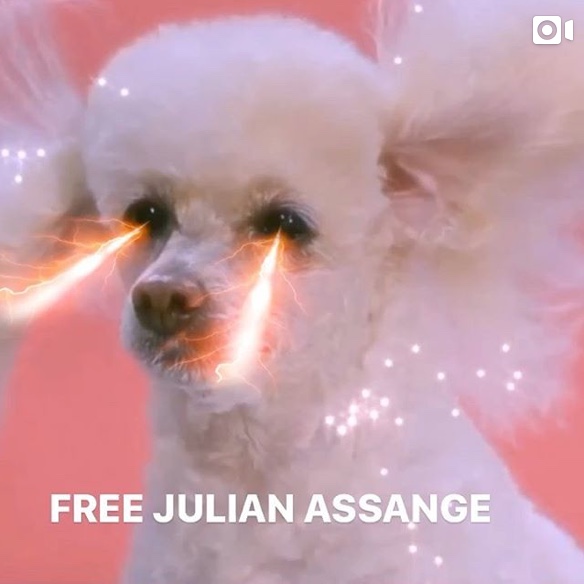
Nina E. Schönefeld, Free Julian Assange (2020)
print collage, 30 x 40cm
Nina E. Schönefeld (b. 1972 in Berlin) is a multidisciplinary artist based in Berlin. She studied Fine Art in Berlin (UdK) and in London (Royal College of Art). She holds a Master of Arts and a PhD in Art History. Schönefeld’s art examines the contemporary social and political climate. Through unusual mediums, objects and videos, the artist questions the contemporary roles of artists, exploring the relationship between art, blockbuster movies and the present digital age. Her stories imagine a dystopian world where, due to drastic political and environmental shift, we need to fight for our democratic rights and survival.
Selected recent exhibitions include: ‘Some Demonstrations’, Manifesta / Manifestina, Zurich (2016); solo show at CoGalleries, Berlin (2016); solo show at Fahrbereitschaft, Berlin (2017); Diskurs Gallery, Berlin (2017); Palazzo Ca’ Zanardi, Venice (2018); Goethe Institute, Beijing (2018); BBA Gallery Award Exhibition, Berlin (2018); solo show at Berlinische Galerie, 12 x 12 IBB Video Space (2018); Villa Heike, Berlin (2019); Lage Egal Gallery, Berlin (2019); Mitte Media Festival, Berlin (2019); Made in NY Media Center by IFP, New York (2019); Bamhaus in Luxembourg (2019); Aram Art Museum, Korea (2019).
The future scenarios in schönefeld’s video installations are intricately linked to current political, environmental and social world issues. In video projects like #freejulian assange #freedomofpress #femaleheroes, #hackerontherun, #trilogyoftomorrow, #contamination, #leftwingprepper, #pandemics, #conspiracy & #enemywithin schönefeld tells stories of hackers, journalists, environmental activists and “out of the box people” in general. The focus lies on radical changes and extreme phenomena like democracies developing into autocracies, escape & persecution of political activists, prepping & survival techniques, hacking & whistleblowing, environmental disasters like nuclear accidents, radical digital inventions like the darknet, conspiracy theories and recently on pandemics.
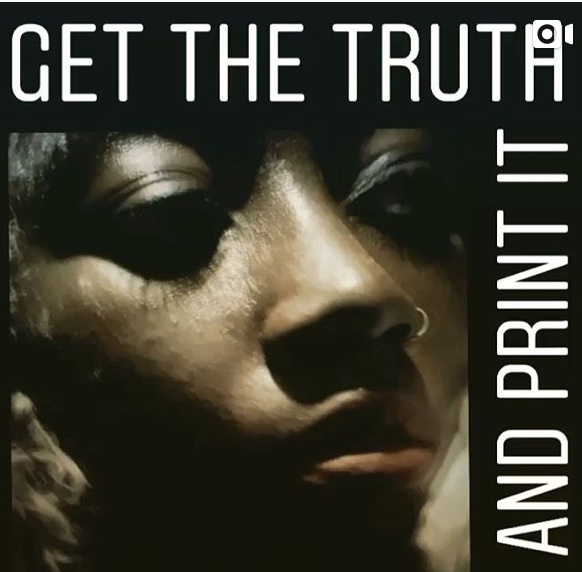
Nina E. Schönefeld, Get The Truth (2020)
print collage, 30 x 40cm
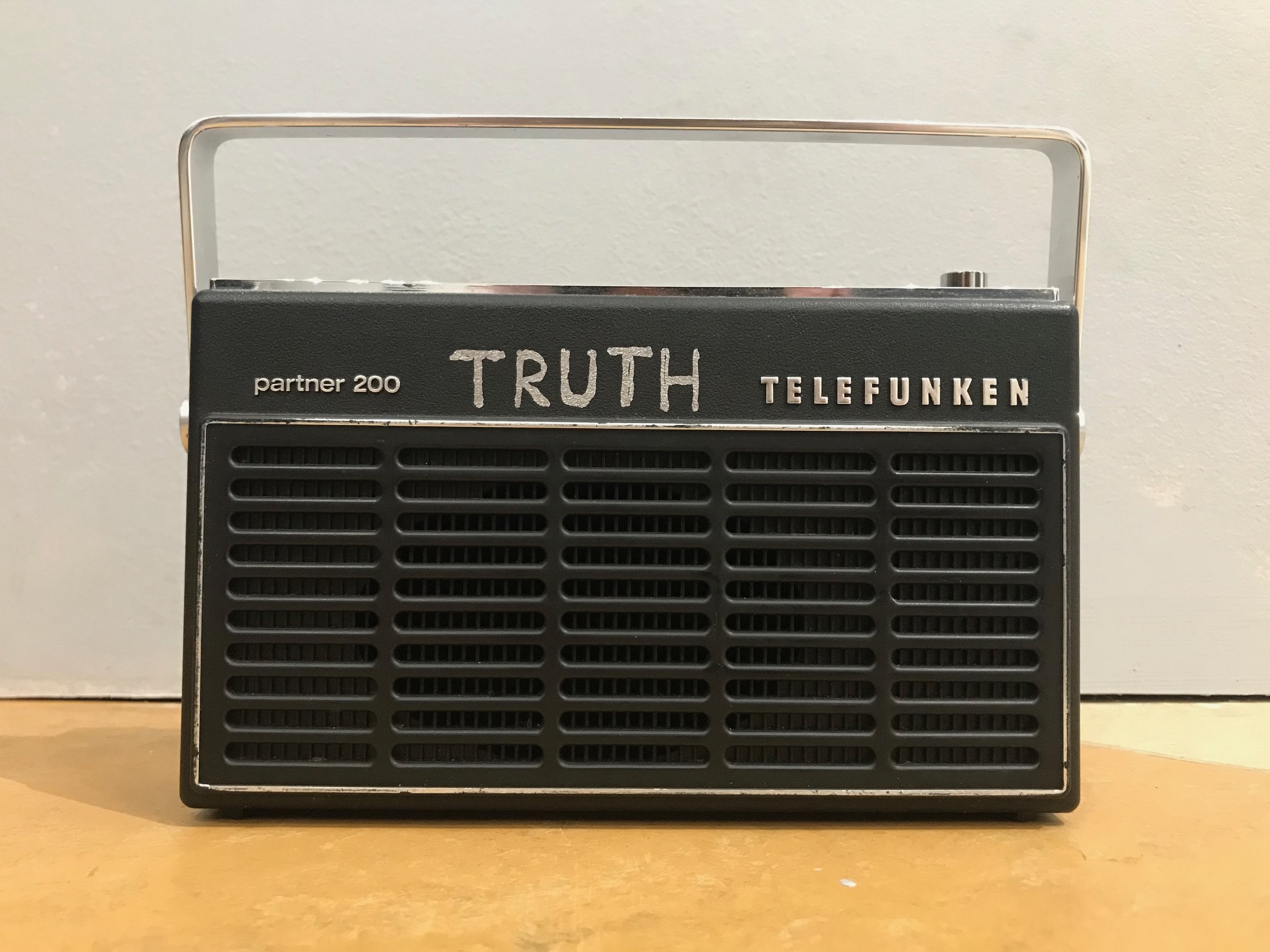
Nina E. Schönefeld, Truth Radio (2019)
installation, found materials: plastic, metal, electronics
Schönefeld’s print collages emerged from a series of media works published on instagram. While her installations made from vintage media objects linked to both autocracies surveillance and the resistance movements struggling against it – old radios, walkie-talkies, monitors, microphones, etc – come out of her video installation Classified Hacker (2019). Echoing the themes of her video work Born To Run (B.T.R.) (2019) and Classified Hacker, Schönefeld addresses the increasing strength of authoritarian autocracies, and the rising restrictions upon journalists and the freedom of speech, as well as the possible extradition of Julian Assange to the US and what this could mean in the future for the situation of independent publicists, whistleblowers and journalists worldwide. Prevalent throughout Schönefeld’s activist practice is a call to start fighting for basic democratic rights.
Varvara Shavrova
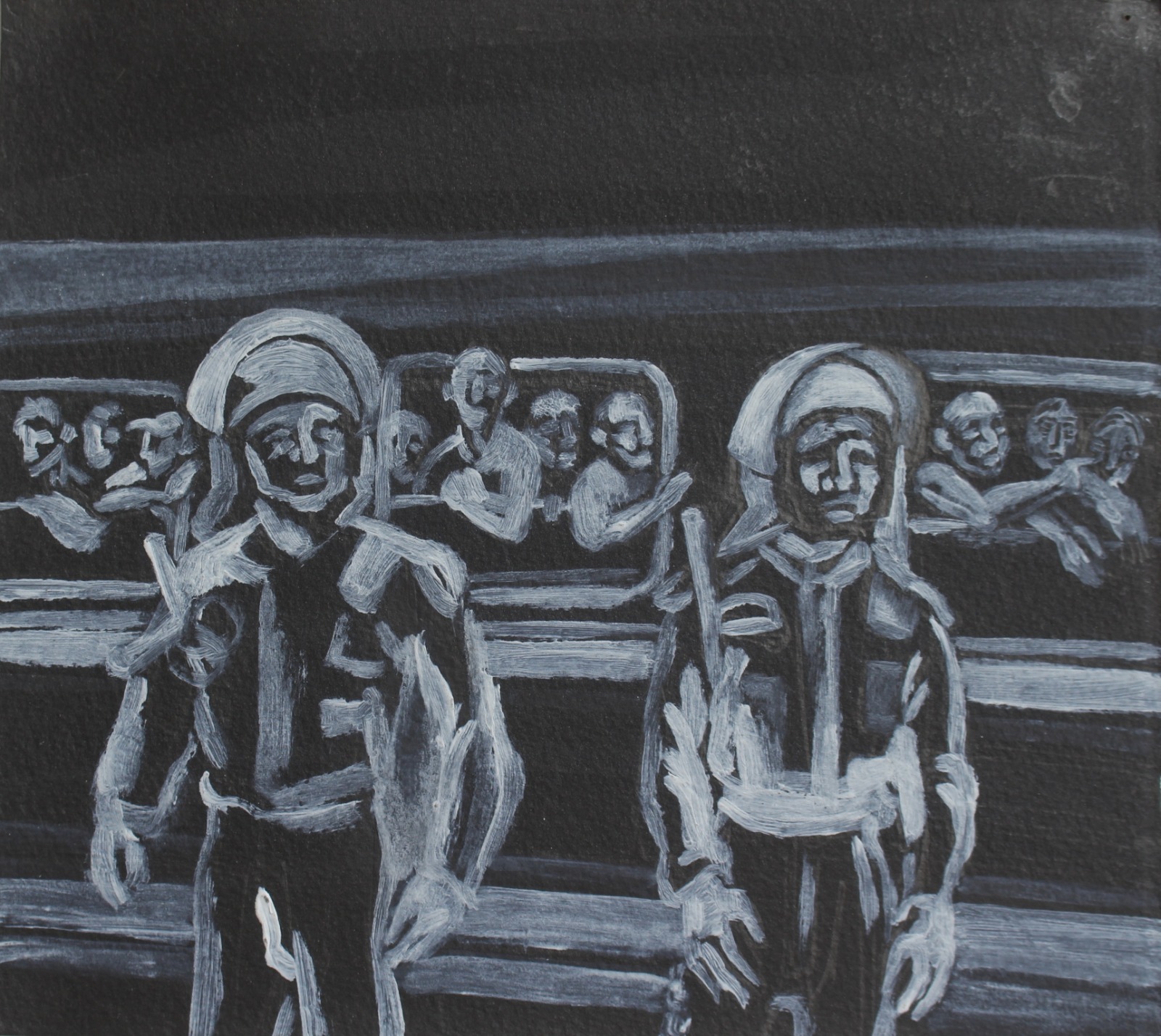
Varvara Shavrova, Migrant Crisis Series (12) (2015-16)
graphite and acrylic on watercolour paper, 25 x 28.5 cm
Varvara Shavrova is a visual artist born in the USSR who lives and works in London and Dublin. Shavrova’s practice is focused on excavating the layers of her family’s history through the process of remembering, recalling, retracing and re-enacting stories. In engaging memory, nostalgia and reflection, Shavrova creates installations that make connections between historic and current narratives, between the archival and the present. Shavrova studied at the Moscow State University of Printing Arts, and received her Masters in Fine Arts from Goldsmiths, University of London. Shavrova received Culture Ireland awards for her solo exhibitions in Beijing, Shanghai and Berlin, British Council award for individual artists, and Ballinglen Arts Foundation Fellowship awards. Shavrova curated international visual arts projects, including The Sea is Limit exhibition at York Art Gallery (2018) and at Virginia Commonwealth University Arts Qatar Gallery in Doha (2019), examining migration, borders and refugee crisis, Giving Voice exhibition of Mary Robinson’s presidential archive in Ballina library in County Mayo, and Map Games: Dynamics of Change, international art and architecture project, at Today Art Museum Beijing, Birmingham Museums and Art Gallery, CAOS Centre for Contemporary Arts, Terni, Italy (2008-2010). Shavrova’s works are included in the collections of the Office of Public Works, the Department of Foreign Affairs and Trade, the MOMENTUM Collection Berlin, the Ballinglen Museum of Contemporary Art, Minsheng Art Museum Beijing, Moscow Museum of Modern Art, and the Museum of the History of St. Petersburg.
Migrant Crisis – Artist Statement
My work examines the themes of migration, borders and borderlines, as they are manifested in Cartesian, territorial, geo-political, and cultural sense. As a Russian who has lived in London and Beijing and now based in Ireland, I belong to the category of many migrant artists who have travelled literally and metaphorically across borders, observing the many ironies and intricacies that they entail, of arbitrary separations and unnatural divisions. Yet in my the works on borders I also observe the long meandering border of rivers and streams, separating land over thousands of years, thereby questioning the relationships between natural and manmade borders, tapping into the ancient origin of societies and cultures fundamentally shaped by such divisions and crossings.
Despite historical notion that borders around the world are permanent, the reality is very different, as borders remain fluid and constantly challenged. Mobility of national borders becomes particularly evident in the light of recent migration from Africa, Asia and the Middle East into Eastern, Central and Western Europe, leading to redefinition and challenges of the existing borders, introduction of tougher border control systems and establishment of new border ethics, that in turn is leading to inevitable transformation of our understanding of the meaning of the term ‘borders’. I am interested in further investigating the mobility of borders in the light of continuing migration across Europe, and in particular developing new works that will reflect on the current state of borders, migration and migrant’s rights.
Variety of approaches I use in order to explore, reflect and comment on migration and borders are multi faceted, and I often work collaboratively, employing a variety of media, including painting, drawing, installation, video, photography and elements of performance. I present my work in the context of traditional institutions, including exhibitions in museums and galleries, whilst exploring alternative approaches and ways of engaging with new audiences, and placing my projects in a wider context of diverse social platforms. I am interested in developing the idea of interpreting the themes of borders, migration and memory through collaborative, participatory and outreach projects, and exploring the themes of borders and migration in the context of projects themselves, where performance borders with sound installation, video migrates into painting, drawings merge with projections.
‘Migrant Crisis’ project renders out the ideas of recent peoples’ movements along, across and through European borders. The work is realized as a deluge of time based drawings created in order to inform a possible end point. These drawings represent the unfolding story associated with the “refugee crisis”, as it has been labeled in the press. I have chosen to catalogue the daily routine of this crisis, its rise in importance through politico-montage and its subsequent fall to the latter regions of the press cycle. In one of the project’s iterations, I have removed it from its paper based origination and created a clustering of the original time based drawings in a looped video, where the work becomes a multiple projection that changes its context from reportage to a multi-level screen installation, that also stimulates a multi sensory response from the viewer.
David Szauder
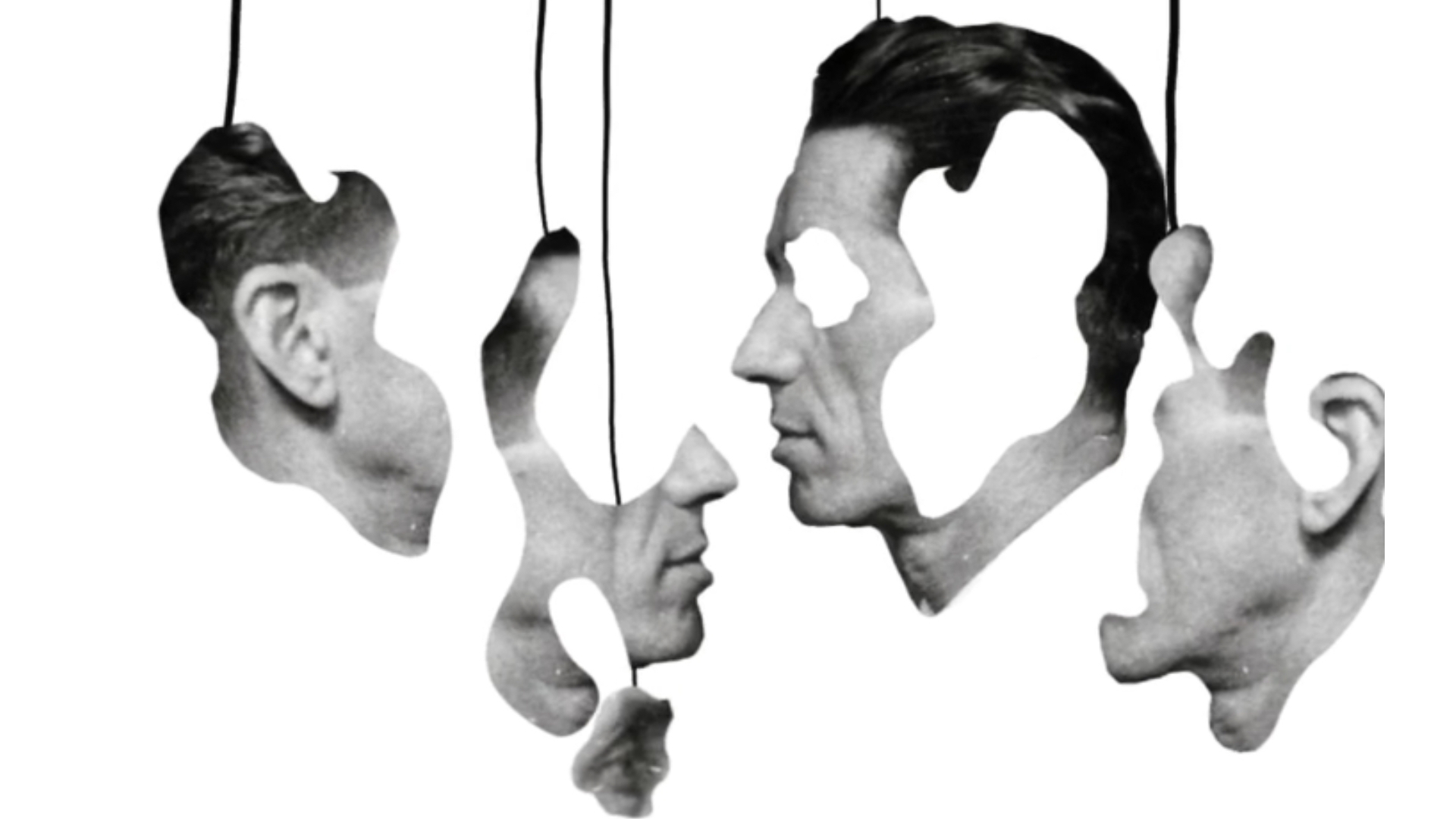
David Szauder, Hanging Around (2020)
video animation, loop
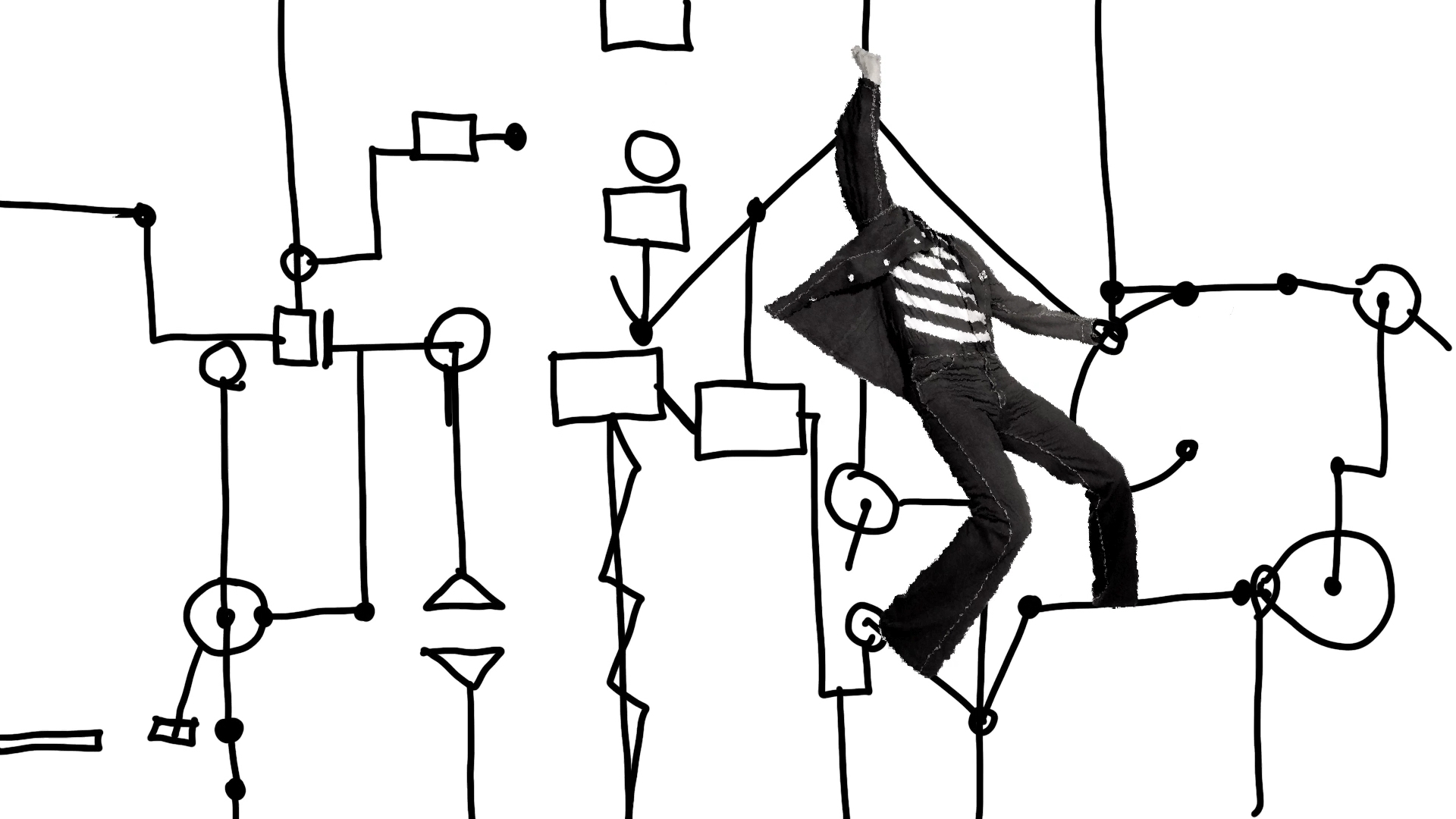
David Szauder, Motivators (2020)
video animation, loop
Media artist David Szauder (b. 1976 in Hungary) studied Art History at the Eötvös Loránd University and Intermedia at the Hungarian University of Fine Arts in Budapest, and completed a Masters Fellowship at the School of Arts, Design and Architecture at the Aalto University in Helsinki. From 2009 to 2014 he worked as the curator at the Hungarian Cultural Institute in Berlin (.CHB). David Szauder is a visiting lecturer at the Film Academy, Potsdam, in addition to leading workshops on interactive media in Berlin and Budapest since 2010. Since 2019, he is the New Media Advisor for the Artistic Director of the VEB 2023 European Capital of Culture.
David Szauder has participated in a variety of international projects as artist and curator. In cooperation with MOMENTUM, previous projects include:
“Art Nomads: Made in the Emirates” at Studio 1, Kunstquartier Bethanien (Berlin, 2016);“Ganz Grosses Kino” KIK Eight at Kino International (Berlin, 2016); MOMENTUM InsideOut: Amir Fattal, “Atara” (Berlin Gallery Weekend, 2015); MOMENTUM InsideOut: “A Time for Dreams” & “Budapest Sketch”(Berlin Art Week, 2014); “PANDAMONIUM Preview // INTERPIXEL: Media Art from Shanghai and Budapest” (Berlin Gallery Weekend, 2014); “INTERSECTION”: Film and Video Art Panel Discussion for Berlinale (Berlin Film Festival, 2014); “THRESHOLDS”: Performance, Exhibition, Discussion (.CHB, Berlin Art Week, 2013); “THRESHOLDS” (TRAFO Center for Contemporary Art, Stettin, Poland, 2013-2014); MOMENTUM InsideOut: “Mass & Mess” (TRAFO Center for Contemporary Art, Stettin, Poland, 2013).
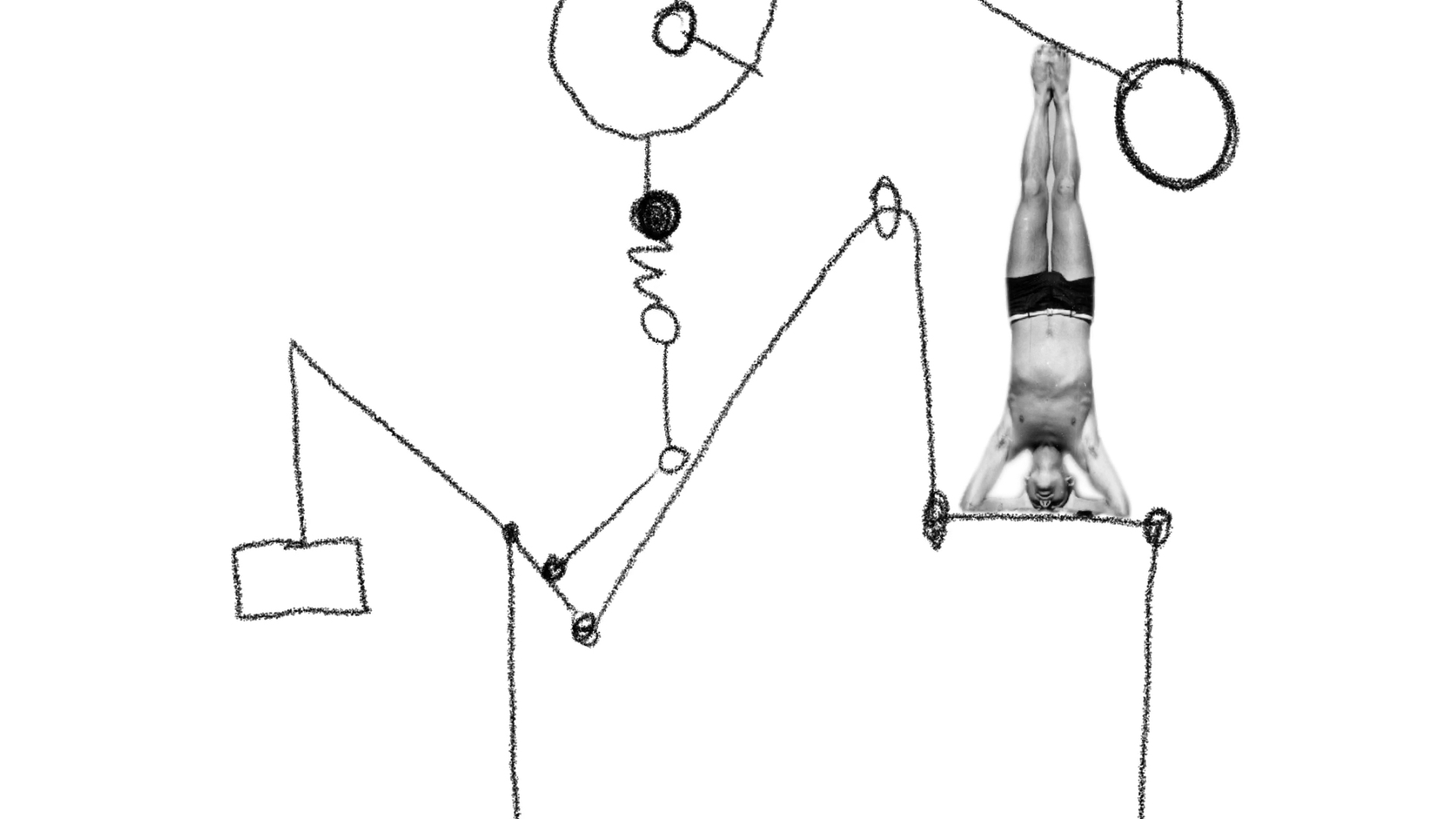
David Szauder, Sunday Meditation
video animation, loop
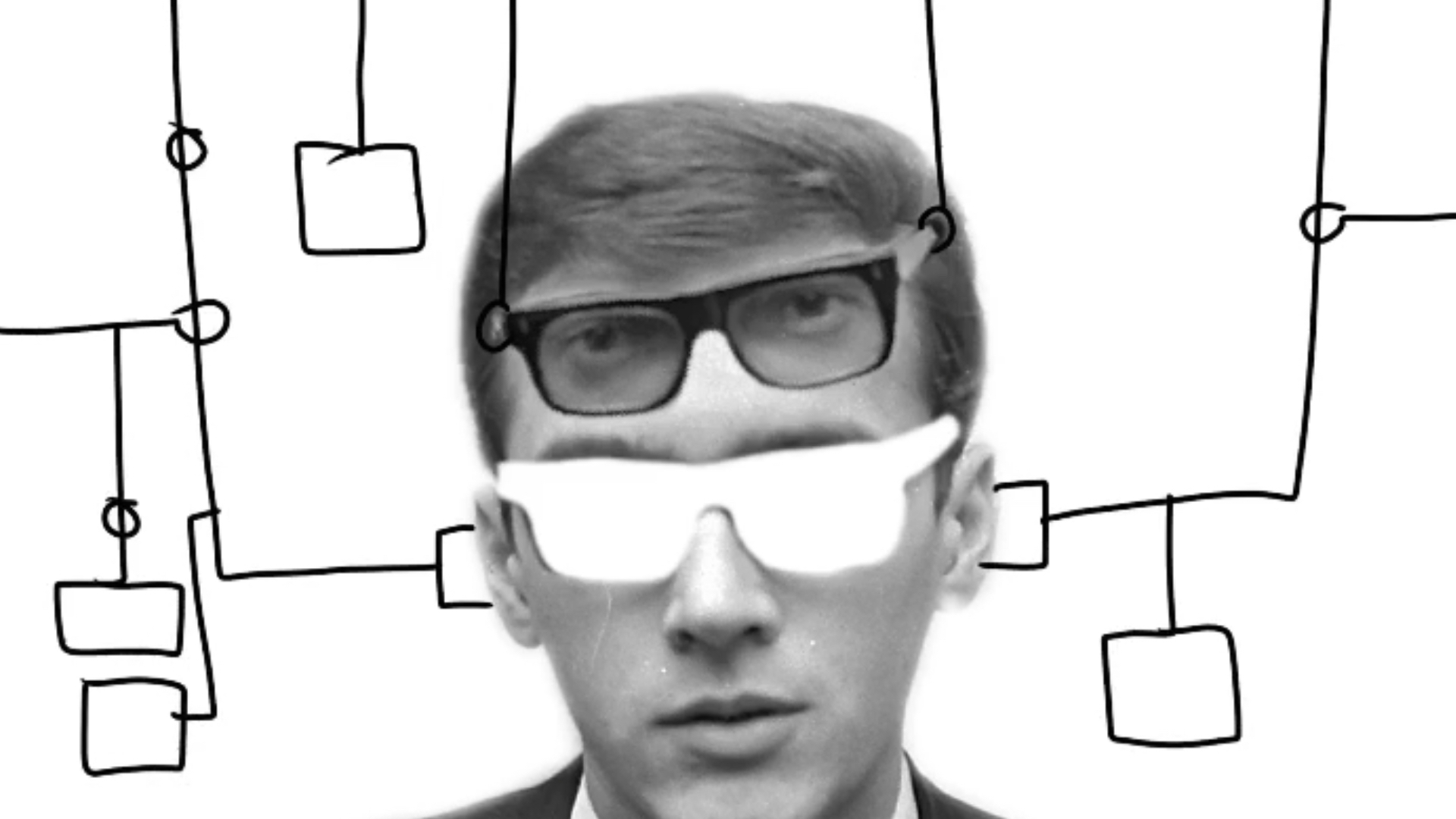
David Szauder, Kinetic Sunglasses Machine (2020)
video animation, loop
4 Easy Pieces – Video Sketches – Artist Statement
These four animations, from an ongoing series of video sketches, are hand drawn animated collages incorporating family photos and found footage. They are kinds of kinetic systems, structures, moving like the ‘perpetuum mobile’. In my case, the perpetuum mobile is the metaphor of the continually changing inner world of mine. There are a good number of nodes which are connected like impossible machines, and the movements of these nodes create an impossible hierarchy or dominations between the elements of the structure. Occasionally the system strives for completion, but these operations are just alibis, the real aim is to keep the movement endless, the structure closed and the hierarchy sustainable. Easy. Like these sketches.
ELYSIUM @ Positions Berlin Art Fair 2020


 Back to Homepage
Back to Homepage

